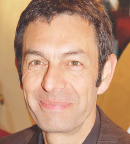
Higher response rates and deeper responses [to venetoclax] were seen in patients with t(11;14), vs those without this translocation.— Shaji Kumar, MD
Tweet this quote
Early-phase studies suggest that venetoclax (Venclexta) holds promise as a treatment for myeloma. At the 2016 American Society of Hematology (ASH) Annual Meeting & Exposition, investigators reported strong activity in heavily pretreated patients, especially those with the t(11;14) translocation and high expression of the BCL2 gene.
Venetoclax is a potent, selective, orally available small-molecule B-cell lymphoma 2 (BCL2) inhibitor. The antiapoptotic proteins BCL2 and myeloid cell leukemia 1 (MCL1) promote survival of myeloma cells.
“The BCL2 family of proteins is responsible for preventing cells from going into apoptosis in response to various damaging stimuli, such as chemotherapy. In other words, the BCL2 proteins help cancer cells survive treatment,” explained Shaji Kumar, MD, Professor of Medicine at the Mayo Clinic, Rochester, Minnesota, who presented the results of a phase I/II study.1
“In the multiple myeloma setting, we know that high expression of BCL2 is common and is also a mechanism of cell survival. Venetoclax directly inhibits BCL2 function. It induces cell death in myeloma cell lines and primary tumor samples, particularly those that are positive for the translocation t(11;14),” he said. The t(11;14) translocation correlates with higher ratios of BCL2 to MCL1 and BCL2 to BCL2-L1 (BCL2-XL) mRNA.
Dr. Kumar noted that venetoclax is the first BCL2 inhibitor to show activity in multiple myeloma. An earlier drug, obatoclax mesylate, inhibited not just BCL2 but multiple proteins, which was likely responsible for the toxicity observed with this drug, he said. “Venetoclax is different,” he explained. “It is an engineered small molecule that was uniquely designed to fit the exact pocket of the protein.”
Monotherapy Trial
In this phase I, open-label study, 66 patients with relapsed or refractory disease received venetoclax monotherapy.1 The aims were to assess safety, pharmacokinetics, maximum tolerated dose, recommended phase II dose, and efficacy. After a 2-week lead-in period with weekly dose escalation, venetoclax was given daily at final doses of 300, 600, 900, or 1,200 mg in dose-escalation cohorts and 1,200 mg in the safety expansion. Patients whose disease progressed during venetoclax monotherapy could receive venetoclax plus dexamethasone and continue in the study (26% of patients did so).
Venetoclax in Multiple Myeloma
- As monotherapy in heavily pretreated patients, venetoclax produced responses in 21% of the entire group and 40% in those with t(11;14) disease.
- In patients who received triplet therapy with venetoclax, bortezomib, and dexamethasone, the response rate was 67%, rising to 97% among patients who were not refractory to bortezomib and had received no more than 3 prior regimens.
- Patients with high expression of BCL2, which is enriched in the t(11;14) subset, had a 94% response rate.
- Favorable results in the t(11;14) subset and in patients with high BCL2 expression point to potential biomarkers for patient selection.
The median number of prior therapies was 5 (range, 1–15), and 62 patients (94%) had received bortezomib (Velcade; 70% were refractory), 62 patients (94%) received lenalidomide (Revlimid; 77% were refractory), and 50 patients (76%) had prior autologous stem cell transplant. A total of 30 patients (46%) had the translocation t(11;14).
Response and Toxicity
The objective response rate was 21% in all patients, with 15% showing a very good partial response or better. In patients with the translocation t(11;14), however, the response rate rose to 40%, including 27% with very good partial responses or better. The response rate without this translocation was 6, Dr. Kumar reported.
“Higher response rates and deeper responses were seen in patients with t(11;14), vs those without this translocation,” he noted. “Venetoclax activity in t(11;14) myeloma was independent of refractory status to prior therapies. We also saw a higher response rate (88%) in t(1;14) patients with a high BCL2:BCL2-L1 gene-expression ratio.”
The median duration of response and the time to disease progression were 9.7 and 2.6 months, respectively, in the overall population. The median duration of response for patients with the translocation t(11;14) was also 9.7 months. Patients who achieved at least minimal response in this translocation group (14 of 30) had a median of 4 prior therapies and were mostly refractory to bortezomib, lenalidomide, or both. The median best percent change in primary M protein for patients with translocation t(11;14) was –53% vs +11% in the group without this translocation or an undetermined status.
Common adverse events (any grade) were nausea (47%), diarrhea (36%), neutropenia (27%), thrombocytopenia (32%), fatigue (27%), anemia (23%), back pain (21%), and vomiting (21%). Grade 3/4 toxicities included thrombocytopenia (26%), neutropenia (21%), lymphopenia (15%), anemia (14%), and decreased white blood cells (14%). No tumor-lysis syndrome was reported.
“We found that venetoclax was safe, without significant side effects. Most of the toxicity was hematologic or gastrointestinal, and all was easily controllable. Patients don’t typically go off this drug because of side effects,” Dr. Kumar noted.
Potential Biomarker Emerges
“Additional biomarker subgroup analyses (n = 32) showed that efficacy was primarily observed in patients with myeloma cells expressing a favorable BCL2 family expression profile (high BCL2, low BCL-XL, low MCL1) by immunohistochemistry, which was significantly enriched in the t(11;14) population,” Dr. Kumar reported. “Indeed, although high BCL2 expression was observed in a majority of bone marrow core biopsy samples (88%), the t(11;14) subgroup was enriched (81% vs 25%) for tumors expressing high BCL2, low BCL-XL, and low MCL1.”
In an interview, Dr. Kumar said this result was not unexpected. “We had seen this in the lab,” he noted. “We know that myeloma cells with t(11;14) have high levels of BCL2 and low levels of MCL1. These cells are more dependent on BCL2, so inhibiting BCL2 leads to the death of those cells. When we look at the t(11;14) patients, we see higher response rates, but when we dig deeper—specifically looking for high BCL2 and low MCL1—we see that eight of nine patients with this profile had a response. We think we may actually have a biomarker that could guide the selection of patients for treatment with venetoclax.”

Antimyeloma activity was observed with this novel combination [venetoclax, bortezomib, dexamethasone], which targets both BCL2 and MCL1. The results support the ongoing phase III trial with this regimen in relapsed/refractory myeloma.— Philippe Moreau, MD
Tweet this quote
Combination Therapy Trial
Also presented at the 2016 ASH Annual Meeting were results of a dose-escalation study combining venetoclax (50–1,200 mg) with bortezomib and dexamethasone, led by Philippe Moreau, MD, of CHU de Nantes, Hotel Dieu-HME in France.2 The overall response rate for the triplet was 67%, rising to 97% among patients who were not refractory to bortezomib and 89% among those with no more than three prior regimens. For bortezomib-nonrefractory patients who received one to three prior lines, the response rate was 97%, Dr. Moreau reported.
Responses were also more durable in patients who were not refractory to bortezomib. The median time to disease progression for these two nonrefractory subgroups was more than 11 months, compared with 1.8 months for bortezomib-refractory patients and 4.3 months for more heavily pretreated patients. Patients with high BCL2 expression also had higher clinical responses, 94%, vs 59% for low expressors of BCL2.
Grade 3/4 adverse events were primarily thrombocytopenia (29%), anemia (15%), and neutropenia (14%).
“Antimyeloma activity was observed with this novel combination, which targets both BCL2 and MCL1,” Dr. Moreau commented. “The results support the ongoing phase III trial with this regimen in relapsed/refractory myeloma.”
Dr. Kumar commented as well. Based on the 94% response rate in bortezomib-sensitive patients and the less heavily pretreated, “which is one of the highest response rates we have seen,” he stated, there is “clearly promise with venetoclax.” ν
Disclosure: Dr. Kumar has served as a consultant for Amgen, Janssen, Sanofi, Noxxon Pharma, Onyx, Glycomimetics, Takeda, Celgene, Kesios, and Bristol-Myers Squibb; received research funding from Janssen, Sanofi, Noxxon Pharma, Onyx, AbbVie, Array BioPharma, Millennium, and Celgene; and received honoraria from Skyline. Dr. Moreau received honoraria from Janssen, Novartis, Takeda, Celgene, Amgen, and Bristol-Myers Squibb and was on the speakers bureau for Janssen.
References


